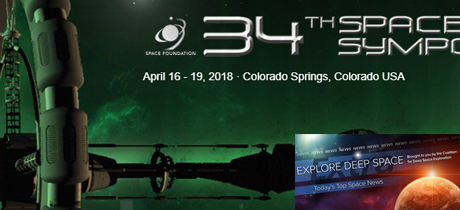In Today’s Deep Space Extra… Washington lawmakers urge support for critical ground systems at NASA’s Kennedy Space Center for the Space Launch System (SLS) and Orion crew capsule. Annual Space Symposium gets underway today in Colorado Springs with a speech by Vice President Mike Pence. NASA’s Transiting Exoplanet Survey Satellite (TESS) to launch this evening.
Human Space Flight
Florida Politics (4/12): Many in Florida’s Congressional delegation are urging their leadership to fully fund ground systems upgrades at NASA’s Kennedy Space Center to accompany development of the Space Launch System (SLS) and Orion crew capsule for future human missions of deep space exploration. The construction of a second mobile launch platform for the SLS is among their concerns. (CORRECTION: Dr. Brian Babin is a member of the U.S. House of Representatives from Texas and chairs the Space Subcommittee there). A bi-partisan group of U.S. Senators is urging similar action. The letters may be found here and here.
Politico Space (4/13): Multinational participation is expected for this week’s annual Space Symposium in Colorado Springs. Vice President Mike Pence, chair of the recently reestablished National Space Council, is among those expected to speak today. Others participating include Commerce Secretary Wilbur Ross, soon to retire NASA Acting Administrator Robert Lightfoot and Eric Fanning, CEO of the Aerospace Industries Association.
NASA authorization bill increases emphasis on commercial partnerships
Space News (4/13): The House Science Committee is scheduled to markup the draft NASA Authorization Act of 2018 on Tuesday. The measure calls for closer ties between NASA and the private sector on pursuits ranging from Earth science to human deep space exploration. It reiterates a $3.2 billion development cap on the Wide Field Infrared Space Telescope (WFIRST), a program the White House has urged Congress to cancel. The proposed legislation seeks more information from NASA as well on plans to end direct funding for the International Space Station in 2024 as part of a plan to transition low Earth orbit activities from the agency to commercial providers.
NASA may fly humans on the less powerful version of its deep-space rocket
The Verge (4/13): In testimony before a U.S. House appropriations panel last week, NASA Acting Administrator Robert Lightfoot outlined possible new options for the first launches of the Space Launch System (SLS) and Orion crew capsule. The first mission is to fly around the moon without astronauts on board in the late 2019-20 time frame. The second mission could fly with astronauts but not with a previously planned upgrade to the second stage of the SLS, an upgrade paced by NASA’s desire to construct a second mobile launch platform. It’s also possible the second SLS mission could launch Europa Clipper, a multiple flyby mission to the ice and ocean covered moon of Jupiter. Europa may host habitable environments.
CNBC (4/13): The fourth attempt was the charm for Mike Massimino, who holds a PhD in mechanical engineering from MIT, in his quest to become a NASA astronaut, a goal spawned by the Apollo explorers. Selected in 1996, Massimino would launch twice on missions to upgrade the Hubble Space Telescope.
Space Science
Get ready for the next big thing in NASA’s search for Earth’s twin
Coalition Member in the News – Orbital ATK
National Public Radio (4/15): NASA’s Transiting Exoplanet Survey Satellite (TESS), a multi-year mission to survey the nearest stars for evidence of extra-solar planets and especially those the size of Earth or a bit larger is being prepared for liftoff on today at 6:32 p.m., EDT, from Cape Canaveral Air Force Station, Florida. The weather outlook is 80 percent favorable. TESS, built by Orbital ATK, is to complement the work of the Kepler space telescope, whose nine-year-old planet search mission is drawing to a close. Findings from both missions will help the James Webb Space Telescope and ground based observatories look for biomarkers in the atmospheres of far off planets.
NEXT-C electric propulsion engine poised for production
Coalition Member in the News – Aerojet Rocketdyne
SpaceFlightInsider.com (4/14): Aerojet Rocketdyne’s xenon fueled electric propulsion thruster, a NASA technology initiative, has cleared the Critical Design Review phase, and will be produced as the propulsion source for NASA’s DART, or Double Asteroid Redirection Test, mission. Planned for 2021-22, DART is to demonstrate a mission to change the course of an asteroid on a possible collision course with the Earth using a spacecraft impactor.
Other News
Business Insider (4/15): More than 23,000 objects the size of a softball or larger, including active and inactive satellites, orbit the Earth posing collision threats. Add to that another 170 million smaller objects, moving a speeds high enough to be damaging if they impact. The U.S. military’s Space Surveillance Network coordinates the tracking of the largest objects and issues the warnings that allow satellite operators to move their spacecraft, including the International Space Station, from harm’s way.
Powerful Atlas V boosts Space Command mission from Cape Canaveral
Coalition Member in the News – United Launch Alliance
Florida Today (4/14): A United Launch Alliance (ULA) Atlas V rocket placed a U.S. Air Force communications satellite into orbit after lifting off from Cape Canaveral Force Station, Florida, on Saturday at 7:13 p.m., EDT.
Major Space Related Activities for the Week
Major space related activities for the week of April 15-21, 2018
Spacepolicyonline.com (4/15): The annual Space Symposium in Colorado Springs, Colorado, gets under with this week, with Vice President Mike Pence scheduled to speak during an afternoon session. Weather permitting, NASA is to launch its TESS extra solar system planet search mission at 6:32 p.m., EDT, from Cape Canaveral Air Force Station, Florida, In Washington, the House Science, Space and Technology will markup a new authorization bill for NASA on Tuesday.

